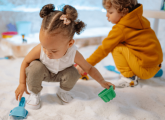Barbara Isaacs looks at how children’s fledgling creative skills can be encouraged and developed…
The Montessori approach is often criticised for not allowing children opportunities to be creative, but this is a fundamental misunderstanding of how it supports children’s creativity. Montessori recognised and valued our ability to be creative; according to her it is one of the key human tendencies. Every new discovery, invention or trend in fashion, art or music needs a person or people with the initiative to explore and apply new ideas in unusual ways. As such, in Montessori settings creativity is seen as a way of thinking and is encouraged.
To express ideas we require tools and skills which help us implement them. This is where Montessori nurseries start when introducing the creative curriculum. Young children are encouraged to develop skills by being given access to high-quality materials and opportunities to repeat activities. The resources need to be plentiful, accessible and appealing, and if necessary are replenished or changed daily by teachers. Such resources include:
● paper of different qualities, sizes and colours
● pencils, crayons, felt tips
● glue (sticks or small pots with spatulas), right- and left-handed scissors, sellotape/masking tape
● string, ribbons, wool, glitter, sequins, pasta, beads, fabrics, paper of different textures, sticks, leaves and petals for collages
● sponges, wood blocks or vegetables for printing
● stencils and objects to draw around
● threading, sewing and weaving activities
● play dough, Fimo or clay
● boxes of different shapes and size
● An easel that the children can use for painting or chalking, with paints and clean brushes ready for use. (Children will be shown where to put their pictures to dry once they are finished and also how to clean the easel in readiness for other children to use.)
The organisation and range of materials should encourage choice. There should be small trays which children use to contain self-selected resources, as well as any tools they may choose to use for their activity. There will also be aprons and mats to use. During a child’s early days at nursery, if they show interest, they will be shown gradually how to:
● roll up their sleeves
● put on an apron
● find a mat
● find somewhere to sit
● where to find paper
● where to find resources
● use the glue stick
● use scissors safely
● thread
● use sewing cards
Initially, they will be guided by the teacher, but as their skills develop and they begin to demonstrate competence, they will access this area of the classroom in the same way as they do other areas of learning – freely and spontaneously. As with other areas of learning, every child will be shown how to return the resources they have not used, and how to clean up their work mat and put away their apron.
Each one of a child’s creative efforts will be supported and appreciated by an adult. Children will also have the opportunity to see what their friends have done – the older, more mature children providing inspiration for the younger ones. In some settings this inspiration may also be given by having an artist or one of the teachers share various techniques and ideas with the children. Rather than formal lessons, these will usually be opportunities for children to observe and be inspired. The child’s own ideas will be scaffolded by the adult, who might suggest the use of various materials, a new technique or tips on how to improve their skills.
Barbara Isaacs is the academic director of Montessori Centre International.

Sand and water table – Getting hands-on with maths
Editors picks
